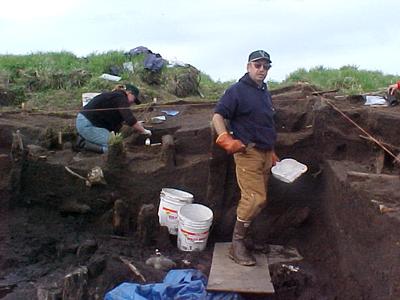19 July, 2001
It is Monday and it is raining, no, not just raining, I mean RAINING!!!
We cannot go out to TEL 079 and 026 because of the weather. We will
make it up on Saturday. Instead, the six of us had a party, yes a
party, but it was a catalog party. All data has to be accounted for.
When we are in the filed excavating, everything must be tagged,
identifying what it is, where it is located and the measurements of
where it is as well as height according to the datum. A datum is a
point of reference in which all measurements are taken from. This gives
a clear understanding of a find and it is uniform for all. Everything
is checked and cross-checked to prevent problems later. All of the
finds will be sent to a laboratory to be analyzed and they need items
to be exact with little human error if possible. This will help Dr.
Harritt with his final report.
It was a little nicer in the afternoon. I decided to go for a walk
along the beach. It was so windy; I had a difficult time standing up. I
made a major decision to go back inside and take a nap. Take a nap and
eat. We have invented many new and exciting food combinations as time
goes on. Look out next years class: WAIT until you try and PB
squared!!!!!!
One has to utilize ones day when you cannot go outside. So, I continued
with my interviews of our team to discuss the many aspects of
anthropology and archaeology. Today I interviewed our fearless leader,
Dr. Roger Harritt. He was an Art History major at Boise State
University. He later received his Doctorate in Anthropology/Archaeology
from the University of Oregon. His dissertation was on the Northern
Alaskan Peninsula, a Late Pre-History of Brooks River. He originally
worked for the National Park Service and now teaches at the University
of Alaska, Anchorage. He is a researcher at ENRI (Environment and
Natural Research Institute), which is at the university. He is
currently pursuing several
projects with the Wales project being his priority. He has been and is
studying how late prehistoric Siberia influences and affected groups in
Alaska. He is studying how the people obtained and developed whaling
technology. The design models are different in the artifacts and
interpretation.
Roger has many objectives to his project in Wales. He is
documenting the stratigraphy (layers of soils and how they tell us
different ages and time in excavating). We are also obtaining a
collection of bones (whale, seal, walrus, caribou, and bear). He is
taking samples of wood and bone and will be having them
radiocarbodated. And he will be taking tissue samples of prehistoric
sea mammals to be compared with modern sea mammals to study to
similarities and differences and to see if there were contaminants
prehistorically. I think Roger Harritt is a busy person. He also has to
deal with six people on this project, which is a job in itself.

I am pictured here working with Maria at TEL 079N

Julie is working in TEL 079N
Contact the TEA in the field at
.
If you cannot connect through your browser, copy the
TEA's e-mail address in the "To:" line of
your favorite e-mail package.
|
